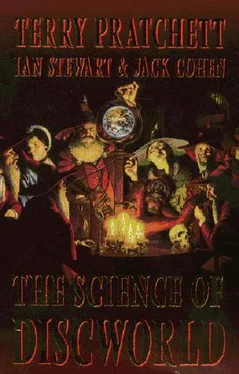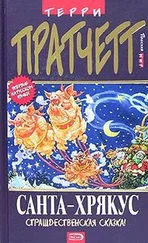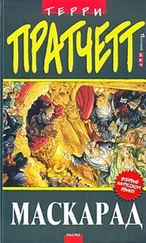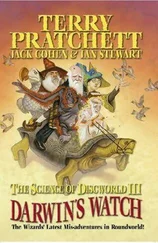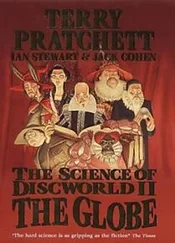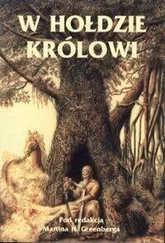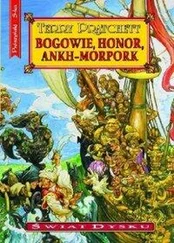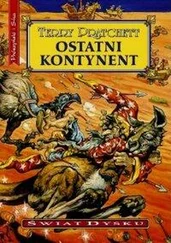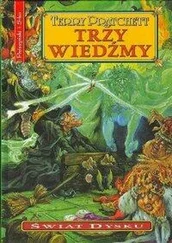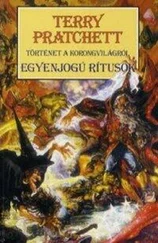Terry Pratchett - Science of Discworld
Здесь есть возможность читать онлайн «Terry Pratchett - Science of Discworld» весь текст электронной книги совершенно бесплатно (целиком полную версию без сокращений). В некоторых случаях можно слушать аудио, скачать через торрент в формате fb2 и присутствует краткое содержание. Жанр: Фантастика и фэнтези, на английском языке. Описание произведения, (предисловие) а так же отзывы посетителей доступны на портале библиотеки ЛибКат.
- Название:Science of Discworld
- Автор:
- Жанр:
- Год:неизвестен
- ISBN:нет данных
- Рейтинг книги:4 / 5. Голосов: 1
-
Избранное:Добавить в избранное
- Отзывы:
-
Ваша оценка:
- 80
- 1
- 2
- 3
- 4
- 5
Science of Discworld: краткое содержание, описание и аннотация
Предлагаем к чтению аннотацию, описание, краткое содержание или предисловие (зависит от того, что написал сам автор книги «Science of Discworld»). Если вы не нашли необходимую информацию о книге — напишите в комментариях, мы постараемся отыскать её.
Science of Discworld — читать онлайн бесплатно полную книгу (весь текст) целиком
Ниже представлен текст книги, разбитый по страницам. Система сохранения места последней прочитанной страницы, позволяет с удобством читать онлайн бесплатно книгу «Science of Discworld», без необходимости каждый раз заново искать на чём Вы остановились. Поставьте закладку, и сможете в любой момент перейти на страницу, на которой закончили чтение.
Интервал:
Закладка:
From this we can deduce more. With only two sets of teeth, the morganucodontids had to have some special trick for feeding their young, something different from the reptiles with their continuous succession of teeth. There isn't room for a full set of adult teeth in a baby shrew, and if teeth only come in two stages, you can't add the odd one every so often as the jaw grows bigger. The easy solution is to have babies with no teeth at all, to start with. But what can they then eat? Something nutritious and easily digested, milk. So we think that milk-production evolved before those high-precision interlocking teeth. This is one reason why the morganucodontids are definitely placed among the mammals.
Amazing what you can learn from a few teeth.
As they prospered and diversified, mammals evolved into two main types: placental mammals, where the mother carries the young in her uterus, and marsupials, where she carries them in a pouch. The marsupial that springs most readily to mind is the kangaroo, possibly because it springs most readily to almost anything, as for example in The Last Continent:
'And ... what's kangaroo for "You are needed for a quest of the utmost importance"?' said Rincewind, with guileful innocence.
'You know, it's funny you should ask that...'
The sandals barely moved. Rincewind rose from them like a man leaving the starting blocks, and when he landed his feet were already making running movements in the air.
After a while the kangaroo came alongside and accompanied him in a series of easy bounds.
'Why are you running away without even listening to what I have to say?'
I've had long experience of being me,' panted Rincewind. 'I know what's going to happen. I'm going to be dragged into things that shouldn't concern me. And you're just a hallucination caused by rich food on an empty stomach, so don't try to stop me!'
'Stop you?' said the kangaroo. 'When you're heading in the right direction?'
Australia alone has over a hundred species of marsupials, in fact most native Australian mammals are marsupials. Another seventy or so are found in the same general region, Tasmania, New Guinea, Timor, Sulawesi, various smaller neighbouring islands. The rest are opossums and some diminutive ratlike creatures, mainly in South America, though ranging into Central America and for one species of opossum right up into Canada.
It looks as though placental mammals generally win out against marsupials, but the difference isn't so great, and if there aren't any competing placental mammals then marsupials do very well indeed. There are even some close parallels between marsupials and pla-centals, a good example is the koala 'bear', which isn't a true bear but looks like an unusually cuddly one.
Most marsupials resemble 'parallel' placentals; a very curious case is the thylacine, otherwise known as the Tasmanian tiger or Tasmanian wolf, which is distinctly wolflike and has a striped rear. The thylacine was officially declared extinct in 1936, but there are persistent reports of occasional sightings, and suitable habitat still exists, so don't be surprised if the thylacine makes a comeback. National Park Ranger Charlie Beasley reported watching one for two minutes in Tasmania in 1995. Similar sightings have been reported from Queensland's Sunshine Coast since 1993: if these sightings are genuine, they are probably of thylacines whose recent ancestors escaped from zoos.
Why such a concentration of marsupials in Australia? The fossil record makes it clear that marsupials originated in the Americas -most probably North America, but that's not so certain. Placentals arose in what is now Asia, but was then linked to the other continents, so they spread into Europe and the Americas. Before placental mammals really got going in the Americas, marsupials migrated to Australia by way of Antarctica, which in those days wasn't the frozen wasteland it is now. Australia was already moving away from South America, but hadn't yet gone all that far, and neither had Antarctica, so presumably the migration involved 'island hopping', or taking advantage of land bridges that temporarily rose from the ocean. By 65 million years ago, oddly enough, the time that the dinosaurs died out, though that's probably not significant -Australia was well separated from the other continents, Antarctica included, and Australian evolution was pretty much on its own.
In the absence of serious competition, the marsupials thrived -just as ground birds did in New Zealand, and for the same reason. But back in the Americas and elsewhere, the superior placental mammals ousted the marsupials almost completely.
Until a few years ago it was assumed that the placentals never made it to Australia at all, except for the very late arrival of rodents and bats from South East Asia about 10 million years ago, and subsequent human introduction of species like dogs and rabbits. This theory was demolished when Mike Archer found a single fossil tooth at a place called Tingamarra. The tooth is from a placental mammal, and it is 55 million years old.
From the form of the tooth it is clear that this mammal had hooves.
Did a lot of placental mammals accompany the marsupials on their migration Down Under? Or was it just a few? Either way, why did the placentals die out and the marsupials thrive?
We have no idea.
Early marsupials probably lived in trees, to judge by their forepaws. Early placentals probably lived on the ground, especially in burrows. This difference in habitat allowed them to coexist for a long time. Marsupial extinctions in the Americas were helped along by humans, who found marsupials especially easy to kill. Humans stayed out of Australia until the Aborigines arrived 40,000-60,000 years ago. When European settlers turned up, from 1815 onwards, they very nearly wiped out numerous marsupial species.
The evolutionary history of the placenta! mammals is controversial and has not been mapped out in detail. An early branch of the family tree was the sloths, anteaters, and armadillos, all animals that look 'primitive', even though there's no earthly reason why they should, because today's sloths, anteaters, and armadillos have evolved just as much as today's everything else's, having survived over the same period.
Mammals really got going during the early Tertiary period, about 66 to 57 million years ago. The climate then was mild, with deciduous forests at both poles. It looks as if whatever killed the dinosaurs also changed the climate, so that in particular it was much more rainy than it had been during dinosaur times, and the rainfall was distributed more evenly throughout the year, instead of all coming at once in a rainy season. Tropical forests covered much of the planet, but they were mainly inhabited by tiny tree-dwelling mammals. No big carnivores, not even big plant-eaters ... no leopards, no deer, no elephants. It took the mammals several million years to evolve bigger bodies. Possibly the forests were much denser than they had been when there were dinosaurs around, because there weren't any big animals to trample paths through them. If so, there was less incentive for a big animal to evolve, because it wouldn't be able to move easily through the forest.
Once mammalian diversity started to get going, it exploded. There were tigerlike animals and hippolike animals and giant weasels. By modern standards, though, they were all a bit lumpish and cumbersome, nothing as graceful as the slim-boned creatures that came later, such as gazelles.
By 32 million years ago, Antarctica had reverted to being an icecap, and the world was cooling. Mammalian evolution had settled down, and what changes did occur were relatively small. There were bear-dogs and giraffe-rhinoceroses and pigs the size of cows, llamas and camels and sylphlike deer, and a rabbit with hooves. By 23 million years ago, the climate was warming up again. Antarctica had separated from South America, making big changes to the flow of ocean currents: now cold water could go round and round the south pole indefinitely. The sea level fell as water got locked up in ice at the poles; with more land exposed and less ocean the climate became more extreme, because land temperatures can change more quickly than sea ones. Falling sea levels opened up land bridges between previously isolated continents; isolated ecologies started to mix up as animals migrated along the new connections. And round about this time, the evolution of some mammals took an unusual turn. A U-turn.
Читать дальшеИнтервал:
Закладка:
Похожие книги на «Science of Discworld»
Представляем Вашему вниманию похожие книги на «Science of Discworld» списком для выбора. Мы отобрали схожую по названию и смыслу литературу в надежде предоставить читателям больше вариантов отыскать новые, интересные, ещё непрочитанные произведения.
Обсуждение, отзывы о книге «Science of Discworld» и просто собственные мнения читателей. Оставьте ваши комментарии, напишите, что Вы думаете о произведении, его смысле или главных героях. Укажите что конкретно понравилось, а что нет, и почему Вы так считаете.
